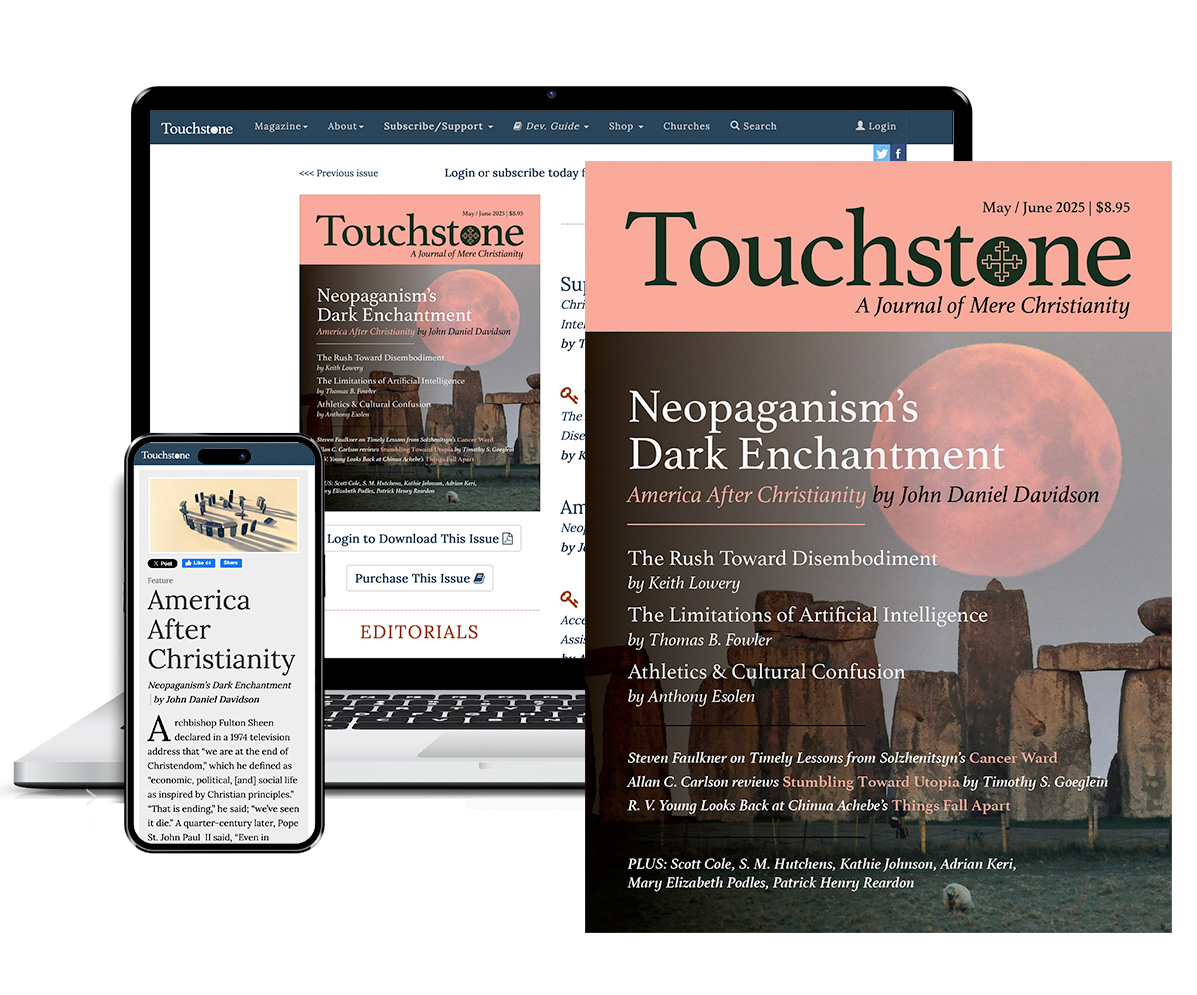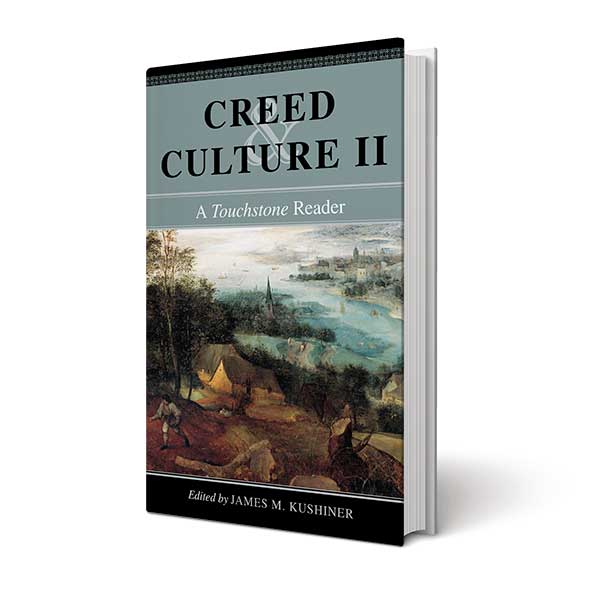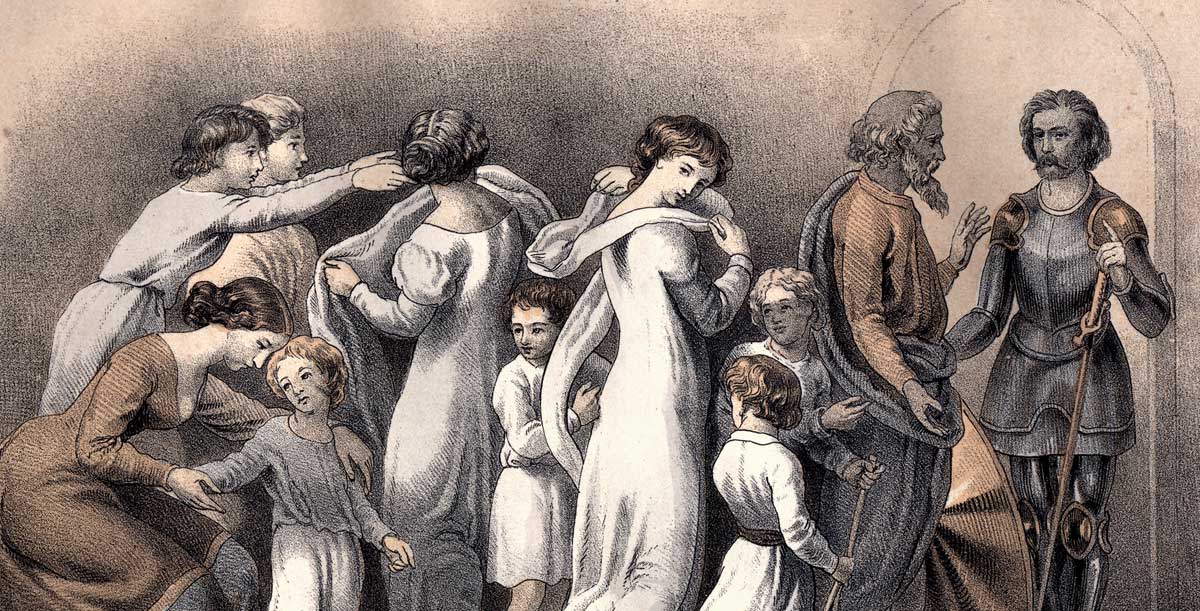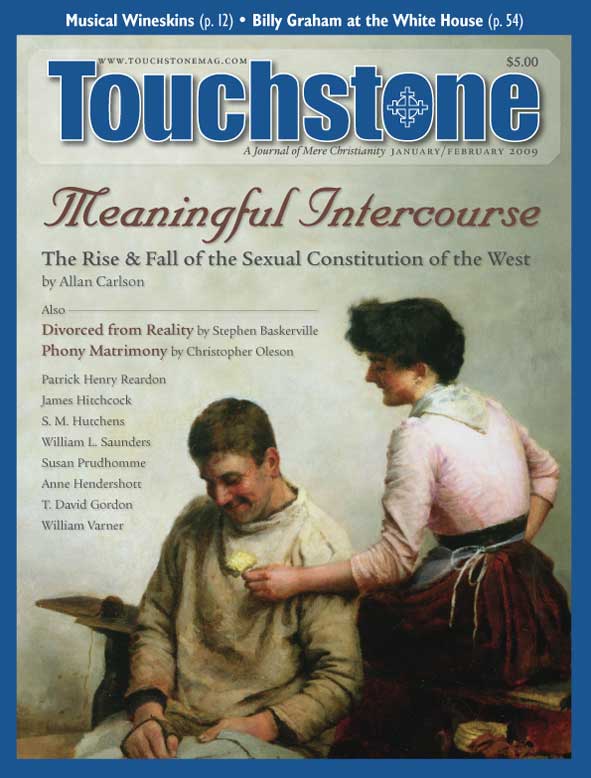Meaningful Intercourse
The Rise & Fall of the Sexual Constitution of Christian Civilization
When Massachusetts officials, facing the court case Goodridge v. Department of Public Health (2003), set out to protect that state’s marriage law from a challenge by seven homosexual couples claiming discrimination, the major line of defense was procreation. Making babies, the state argued, was the first purpose of marriage. By definition, same-sex partners could not create a child as a couple. This was important, the state’s argument continued, because children usually do best when growing up with their two natural parents.
And the initial trial court, let us remember, agreed with the state. The judge ruled that the primary purpose of marriage, under Massachusetts law, was in fact procreation. Accordingly, the court concluded that the state could reasonably distinguish between homosexual claimants to marriage and those heterosexual couples who were at least “theoretically . . . capable” of procreation without relying on “inherently more cumbersome” reproductive methods.
But of course, the trial court’s decision did not survive appeal to the Massachusetts Supreme Judicial Court. This higher court, on a 4–3 vote, dismissed the procreation argument, pointing to opposite-sex couples in which the woman was over childbearing age or that were otherwise infertile. Could the state “rationally” tell them that they could not marry? No, it could not. Indeed, the court noted that, under state law, even those “who cannot stir from their death bed” could marry, provided they were of the opposite sex. Last year, the Supreme Court of California similarly dismissed the procreation argument when it struck down that state’s marriage law as discriminatory.
In his book Why Marriage Matters, Evan Wolfson dissects the legal appeal to procreation, finding it in the end “riddled with holes.” If making babies is the purpose of marriage, he argues, then the marriages of Bob and Elizabeth Dole, John and Teresa Heinz Kerry, Pat and Shelley Buchanan, and even George and Martha Washington should all have been declared invalid. Another same-sex activist, Dale Carpenter, argues that if there were any merit to the procreation argument,
we would require prospective married couples to sign an affidavit stating that they are able to procreate and intend to procreate. If in, say, 10 years they had not procreated, we could presume they are unable or unwilling to do so and could dissolve the marriage as unworthy of the unique institution.
He adds that since no one has really proposed this, or anything like it, it is clear that the defenders of conventional family law “do not take the narrow procreationist view of marriage very seriously.”
Indeed, that usually faithful, conservative Supreme Court Justice Antonin Scalia, in his 2003 dissent in Lawrence v. Texas, noted:
If moral disapprobation of homosexual conduct is [of] ‘no state interest’ . . . what justification could there possibly be for denying the benefits of marriage to homosexual couples? Surely not the encouragement of procreation, since the sterile and the elderly are allowed to marry.
It is fair to conclude, I think, that use of the “procreation argument” to define the scope of marriage is in serious trouble.
Immediate questions become: Where did the bond between monogamous marriage and procreation come from? Why is it no longer self-evident? And what are the consequences of this change?
Sex & Civilization
Turning to the first question—where did the bond between monogamous marriage and procreation come from?—my answer is simple: It is nothing less than the foundation of the unwritten Sexual Constitution of Western Civilization.
Nearly two thousand years ago, what would become Western Christian civilization began to take form in a time of growing sexual disorder. The moral and family disciplines of the old Roman Republic were fading, being replaced by the intoxications of empire. Slave concubinage flourished in these years. Divorce by mutual consent became easy and common. Adultery was fashionable and widespread.
In the swollen city of Rome, homosexuality emerged as an open practice. Indeed, there is some evidence that same-sex “marriage” occurred. As a poem attributed to the late second century put it: “The bearded Callistratus married the rugged Afer/ Under the same law by which a woman takes a husband./ Torches were carried before him, a bridal veil covered his face.”
There was also a disregard for infant life, with infanticide and abortion regular practices. St. Ambrose wrote in the fourth century: “Women are in a hurry to wean their children; if they be rich, they scorn to suckle them; poor women expose their children; and if found, refuse to take them back; the rich, rather than see their fortune divided, use murderous juices to kill the fetus within the womb.”
As early as 18 B.C., Caesar Augustus, worried about the plummeting Roman birthrate, implemented the so-called Augustan Laws, measures that punished adultery, penalized childlessness, and showered benefits on families with three or more children. These laws appear to have slowed the empire’s demoralization for about a century. Thereafter, the old trend lines returned.
Between A.D. 50 and 400, and out of this same circumstance, the Fathers of the Christian Church—and in this case perhaps the usually unheralded Mothers of the Church as well—crafted a new sexual order. Procreative marriage served as its foundation. Importantly, they also built this new order in reaction to the Gnostic heresies that threatened the young Church; and perhaps even human life itself.
The Gnostic idea rose independently of Christianity, but I am concerned here with so-called Christian Gnosticism. The Gnostics drew together myths from Iran, Jewish magic and mysticism, Greek philosophy, and Chaldean mystical speculation. More troubling, they also appealed to an exaggerated freedom from the law, said to be proclaimed by Jesus and Paul. In this sense, they were antinomians; that is, they believed that the gospel freed Christians from obedience to any law, be it scriptural, civil, or moral.
The Gnostics claimed to have a special “gnosis,” a “secret knowledge” denied to ordinary Christians. They appealed to unseen spirits. They denied nature. While they developed a mélange of moral and doctrinal ideas, most Gnostics appear to have shared two views: They rejected conventional marriage as a child-related institution, and they scorned procreation.
This heresy posed a grave challenge to the early Christian movement. Indeed, the Epistles are full of warnings against Gnostic teachings. In 1 Timothy 4, for example, Paul writes that “some will depart from the faith by giving heed to deceitful spirits and doctrines of demons . . . who forbid marriage.” In Jude 4 we read that admission into the Christian community “has been secretly gained by . . . ungodly persons who pervert the grace of our God into licentiousness.” 2 Peter tells of false prophets corrupting the young church: “irrational animals, creatures of instinct . . . reveling in their dissipation, carousing with you. They have eyes full of adultery, insatiable souls.”
Relative to sex, it appears that Gnosticism took two forms. One strand emphasized total sexual license. Claiming the freedom of the gospel, these Gnostics indulged in adultery and ritualistic fornication. The Church Father Irenaeus pointed to those who “introduced promiscuous intercourse and marriages . . . [saying] that God does not really care about these matters.” Epiphanius, a future bishop of Salamis, described in detail his involvement as a naive young man with a secret Gnostic group in Egypt that had infiltrated a local church in about A.D. 335. After a lavish meal of meat and wine, he said, the men of this group would exchange their wives and “indulge in promiscuous intercourse.” This would be done, he noted, “not to beget children, but for mere pleasure.” The group’s rituals included grotesque perversions of the Holy Eucharist. In this episode ninety members of the congregation were eventually excommunicated.
Other Gnostics of the libertine persuasion taught that “marrying and bearing [children] are from Satan,” and that the true believer should enjoy every possible sexual experience.
In marked contrast to this polymorphous romp, a second Gnostic strand totally rejected sexuality. Tatian led a faction called the Encratites, or “the self-controlled.” According to Irenaeus, they “attacked marriage as corruption and fornication.” He also complained that these Encratites rejected “the ancient work of God in forming mankind and implicitly blam[ed] Him—God—for making male and female for the generation of men.”
The so-called Gnostic Gospels drove these points home. In the Gospel According to the Egyptians, Salome asks: “How long shall men die?” Jesus is said to answer: “As long as you women bear children.” From this, the ascetic Gnostics concluded that they could defeat death by ceasing procreation. They also celebrated androgyny, since a being without sexual identity could obviously not be procreative. The Gospel of Thomas, a favorite of modern feminist theologians, has Jesus saying: “Every woman who makes herself male enters the Kingdom of Heaven.”
Within the broad context of a Roman civilization sliding into family breakdown and sexual anarchy, the young Christian Church faced as well this infiltration of life-denying ideas into its own ranks. For Christian leaders, the question became: Just what is marriage for?
On Christian Marriage
Answers came from several sources. Church leaders noted, for example, the fierce hatred shown by the Gnostics toward the Hebrew Scriptures. From Judaism, accordingly, the Christian could see children as a divine blessing for their parents and for the community as a whole. As told in Deuteronomy: “And because you harken to these ordinances, and keep and do them, the Lord your God will love you, bless you, and multiply you. . . . You shall be blessed above all peoples; there shall not be male or female barren among you” (7:12–14). Throughout the centuries, the Jewish sages also declared that “he who does not engage in procreation is as if he diminished the divine image.”
A second Jewish inspiration may have been the small, ascetic Essene community, now famed for compiling the Dead Sea Scrolls. According to the first-century historian Josephus, members of this order entered marriages “not for self-indulgence, but for the procreation of children.”
Still another source may have been Philo, a Jew trained in Greek philosophy, who expressed revulsion over pagan Roman pleasure seeking. “Like a bad husbandman,” he wrote, “[the homosexual] spends his labor night and day on soil from which no growth at all can be expected.” The sexual act was for procreation, Philo insisted. Seeking a consistent sexual standard, he also opposed marriage to women known to be sterile.
Another source for early Christian leaders was apparently the Stoic ideal. Also repulsed by the sexual excesses of first- and second-century Rome, the Stoics—including philosophers such as Epictetus and Musonius Rufus—summoned reason to control human desires and behavior. They also held that there was a natural law which gave order to human life. Sexual intercourse in marriage, the Stoics concluded, found its clear and natural purpose in the propagation of the human race. However, intercourse only for pleasure was suspect. As the first-century Stoic Seneca declared:
All love of another’s wife is shameful; so too, too much love of your own. A wise man ought to love his wife with judgment, not affection. . . . Nothing is fouler than to love a wife like an adulteress. . . . Let men show themselves to their wives not as lovers, but as husbands.
And of course, these early Christian leaders also drew on the Gospels and the letters of Paul. The orthodox Gospel texts showed Jesus attending the wedding feast at Cana and performing there his first miracle. Jesus also condemned adultery and divorce. In 1 Timothy 2:15, Paul taught that “woman will be saved through bearing children.” And in Ephesians 5, he equated the marital love of husband and wife to the bond between Christ and his Church.
All of these influences guided the early church leaders to one conclusion: The first purpose of marriage is procreation. While also praising lifelong chastity, they refused to abandon the need for children. As Justin explained in the mid-second century: “We Christians either marry only to produce children, or, if we refuse to marry, are completely continent.” Consistent with Greek and Roman ideals and recent Jewish practice, Christians also insisted on monogamy: one woman married to one man, for life.
In the year A.D. 400, Augustine, bishop of Hippo, wrote the book On the Good of Marriage. He argued that God desired man’s perpetuation through marriage. Offspring, he insisted, were an obvious “good” of marriage (the other two being fidelity and sacramental union). As Augustine elaborated:
What food is to the health of man, intercourse is to the health of the human race, and each is not without its carnal delight, which cannot be lust if, modified and restrained by temperance, it is brought to a natural use [i.e., procreation].
Augustine also insisted that the act of procreation included “the receiving of [children] lovingly, the nourishing of them humanely, the educating of them religiously.”
A Lasting Morality
In this way, the bond of monogamous marriage to procreation became a vital foundation for emerging Western Christian civilization. The sexual disorders of the late Roman Empire and the life-denying fanaticism of the Gnostics retreated before a new marital morality. And, as fully articulated by Augustine in the year 400, this moral order essentially lasted for another 1,500 years.
Even the tremors of the Protestant Reformation in the sixteenth century arguably strengthened this powerful tie between procreation and monogamous marriage. The Augustinian monk turned reformer Martin Luther, for example, believed that God’s words in Genesis 1:28, “Be fruitful and multiply,” represented more than a command; they were, he said, “a divine ordinance which it is not our prerogative to hinder or ignore.” This led him to reject celibacy as a special spiritual state and to urge priests, monks, and nuns to marry and have children. As Luther wrote: “We were all created to do as our parents have done, to beget and rear children.”
It is true that Protestantism did inject more passion and intimacy into the marital bond than would have been considered seemly by the early Church Fathers. Still, these emotions remained tightly bound to procreation. Consider, for example, a poem written by the Puritan wife Anne Bradstreet to her husband Simon, who was among the founders of the Massachusetts Bay Colony in 1630. It is entitled “A Letter to Her Husband, Absent upon Publick Employment”:
I, like the earth this season, mourn in black,
My Sun is gone so far in’s Zodiack,
Whom whilst I ’joy’d, nor storms, nor frosts I felt,
His warmth such frigid colds did cause to melt.
My chilled limbs now nummed lye forlorn;
Return, return sweet Sol from Capricorn;
In this dead time, alas, what can I more
Than view those fruits which through thy heat I bore.
The “fruits” referred to here are, of course, their children, the offspring of Christian marital ardor.
Closer to our time, attitudes toward birth control revealed the continuing strength of the bond between monogamous marriage and procreation. In 1873, the US Congress approved and President Grant signed the Comstock Law, so named for its chief advocate, Anthony Comstock, agent of the Young Men’s Christian Association. Its provisions included prohibitions on the import, sale, or distribution by mail of items or information designed to prevent conception or induce abortion. A majority of states passed so-called mini-Comstocks, forbidding the possession of contraceptives or abortifacients. The toughest law, found in Connecticut, also criminalized the use of contraceptives.
What was Comstock’s alternative to birth control in difficult circumstances? “Self-control,” an excellent summation of the Christian view.
In 1917, no less a body than the Massachusetts Supreme Judicial Court ruled in favor of a mini-Comstock law prohibiting the possession of contraceptives. As the Massachusetts Court reasoned:
[The law’s] plain purpose is to protect purity, to preserve chastity, to encourage continence and self restraint, to defend the sanctity of the home, and thus to engender in the State and nation a virile and virtuous race of men and women.
Indeed, as late as 1930, no less a figure than Sigmund Freud noted in his book Civilization and Its Discontents that Western civilization had prohibited by law most of the possible forms of sexual expression. He continued:
[Even] heterosexual genital love, which has remained exempt from outlawry, is itself restricted by further limitations, in the shape of insistence upon legitimacy and monogamy. Present-day civilization makes it plain that it will only permit sexual relationships on the basis of a solitary, indissoluble bond between one man and one woman, and that it does not like sexuality as a source of pleasure in its own right and is only prepared to tolerate [pleasure] because there is so far no substitute for it as a means of propagating the human race.
Freud was clearly not happy about those restrictions, and his words lack poetry or any sense of sacred mystery and marital joy. All the same, they testify to the survival of the West’s Sexual Constitution well into the twentieth century.
On Contraception
The 1917 appeal by the Massachusetts Supreme Judicial Court to “a virile and virtuous race of men and women” would in fact unravel during the second half of the twentieth century. This story could be told many ways; I want to focus on just two episodes: the legalization of contraception in the United States; and the disappearance of the concept of illegitimacy in Sweden.
The US Supreme Court’s 1965 ruling in Griswold v. Connecticut stands in ever sharper relief as a profound break in American, and Western, history. Importantly, in overturning this “mini-Comstock” law preventing contraceptive use, the US Supreme Court claimed to discover for the first time “penumbras” around and “emanations” emerging from the Bill of Rights, legal spirits that created “zones of privacy” hitherto undetected by federal judges. (Curiously, such strange language would have been quite familiar to a first- or second-century Gnostic.) Cynically (given what would soon follow), the Court’s opinion appealed to “the sacred precincts of marital bedrooms,” to “the notions of privacy surrounding the marriage relationship,” and to this bond’s “sacred” nature to justify the decision.
In truth, Griswold can be read in retrospect as a fundamental challenge to Western civilization’s unwritten Sexual Constitution. As Wolfson correctly states, “The Court recognized [in Griswold] the right not to procreate in marriage.” Only six years later, in the case Eisenstadt v. Baird, the Supreme Court appealed to the very same “penumbras” and “emanations” from the Bill of Rights, and to the same “right of privacy,” to declare marriage largely empty of meaning. Here’s the key passage:
It is true that in Griswold the right of privacy in question inhered in the marital relationship. Yet the marital couple is not an independent entity with a mind and heart of its own, but an association of two individuals each with a separate intellectual and emotional makeup. If the right of privacy means anything, it is the right of the individual, married or single, to be free from unwarranted governmental intrusion into matters so fundamentally affecting a person as the decision whether to bear or beget a child.
With this decision, the Constitution’s “penumbras” and “emanations” now denied the substance of both publicly sanctioned marriage and its grounding in the natural law.
A year later, the same secret knowledge led the Supreme Court to overturn the abortion laws of all fifty states, creating a new “right to abortion.” (Again, this was a move that would surely have pleased the baby-loathing Gnostics.) In 1992, the Court appealed to “the right to define one’s own concept of existence, of meaning, of the universe, and of the mystery of human life” in its reaffirmation of abortion rights. (Actually, such language is very close to the definition of the Gnostic idea.) And in 2003, the Supreme Court in Lawrence v. Texas summoned the same “penumbras” and “emanations” of the Bill of Rights to find a right to uninhibited sexual expression, in this case a right to sodomy. (Yet again, at least one branch of the Gnostics would have been delighted.)
On Illegitimacy
The decline and fall of the concept of “illegitimacy” also points to the disappearance of the bond between marriage and procreation. The cultural and legal term “illegitimate birth” obviously sought to use fear and the prospect of shame to help confine sexual relations and childbearing to marriage. As Freud noted, “legitimacy” was part and parcel of our civilization’s moral code; or, in my terms, its Sexual Constitution. And yet, most persons today are deeply bothered by the obverse term, “illegitimacy.” To the contemporary way of thinking, it punishes innocent children for the sins or acts of their parents. Even so, this concept proved highly resilient—until the end of the twentieth century.
There were earlier attempts to banish “illegitimacy.” During the French Revolution, the Law of 12 Brumaire (November 2, 1793) intended to sweep away all laws that distinguished between legitimate and illegitimate children. As the revolutionaries triumphantly declared in 1794, “There are no bastards in France!” And yet the change was opposed in the countryside, and never really enforced by the courts. The law was repealed in 1803.
In 1918, the Bolshevik revolutionaries in Russia also abolished “illegitimacy,” with the new Soviet Family Law Code stating: “Birth itself shall be the basis of the family. No differentiation whatsoever shall be made between relationship by birth in or out of wedlock.” This was part of a larger Communist project to eliminate marriage and the natural family altogether, the means of which included divorce on request by either spouse and the equation of cohabitation with marriage. The law also imposed a duty of support on unmarried fathers. And yet, these reforms did not work. Child abandonment grew common. Vagrant children filled the land. In the end, even the political monster Joseph Stalin acknowledged failure. A new Family Code, introduced in 1944, specified that only a registered marriage created rights and duties between parents and a child. The idea of “illegitimacy” returned.
However, where the Jacobins and the Communists failed, Sweden’s Democratic Socialists would succeed during the last three decades of the twentieth century. Into the early 1960s, the Swedish marriage system remained relatively strong. The status of being born “in wedlock” still brought with it distinctive legal claims relative to inheritance, property, and other matters. It was only during Sweden’s so-called Red Years, 1967–1976, that real changes occurred. Under heavy feminist influence, the Democratic Socialist government set out to abolish the roles of husband and wife, to make divorce easy, to eliminate marriage as an economic unit, and to raise the status of cohabitation to equality with marriage.
Notably, in 1976—at the very end of this radical reform—the government deleted the distinction between “in” and “out of” wedlock from all its statutes. This fully severed the legal bond between marriage and procreation. To accommodate the needs of single mothers, the Social Democrats also had to expand the welfare state, with government now supplying most of the support and care of children once given by families: from universal health insurance to state day care subsidies to school meals. With the home functionally dismantled, and with procreation unrelated to marriage, it was an easy and almost logical step to extend marriage-like “registered partnerships” to same-sex couples in 1995.
The leveling “right of privacy” in America and the triumph of socialism over the home in Sweden: both contributed to the successful repeal of the Sexual Constitution of Western Civilization, which had rested on the bond of monogamous marriage to procreation.
The New Gnostics
In intellectual terms, the remarkable development over the last several decades has been the return of the Gnostic idea in a new form. It shapes everything from modern feminist theology (consider Elaine Pagels’s bestselling Beyond Belief: The Secret Gospel of Thomas), to popular literature ( The Da Vinci Code, over one hundred weeks atop the New York Times best-seller list, was an openly Gnostic text), even to the reasoning of our highest court. Nothing that Western civilization has considered natural, traditional, sacred, or moral is safe from the Gnostic idea. And no appeal to nature, to history, to culture, or to human experience of any kind can prevail against the “special knowledge” of the modern antinomians.
In America, it now seems clear that the “right of privacy,” conceived by the Supreme Court 43 years ago, is the foe of both Christian marriage and procreation separately, and is especially hostile when they are united. It also seems clear that the key battles in defense of this union occurred decades ago, long before most persons even imagined same-sex marriage. And those battles were lost over questions that, speaking frankly, relatively few citizens of the early twenty-first century are really prepared to reopen. How many are ready to argue for the recriminalization of contraceptives? How many want to advocate a strict legal and cultural imposition of the word, “illegitimate,” on certain little children?
If my analysis is correct, if the Sexual Constitution of Western Civilization has indeed been both abandoned and overthrown during the last 60 years, what would be the predictable consequences? Well, we would see:
• among the native born, a low and falling birthrate;
•
among the children continuing to be born, an ever-growing number being born
to unmarried women;
•
pornography growing ubiquitous;
•
homosexuality becoming acceptable, even normal;
•
legalization of abortion and promotion of contraception by the state;
•
public welfare costs soaring as family networks prove unable to care for the
young, the sick, the handicapped, and the old;
•
sexual diseases multiplying in kind and virulence;
•
children being inducted into sexual knowledge and practices at ever younger
ages; and
•
political borders being overrun by new “barbarians” with stricter
sexual and moral codes.
Does any of this sound familiar?
Perhaps a broader lesson from the Western Christian experience is that building or renewing a civilization is hard work, requiring difficult tasks. In a flourishing civilization, both the elites and the great majority of the common people accept and internalize—without question—an array of assumptions, codes of conduct, and moral guides; any skeptical minority must acquiesce, or face sanctions. However, renewing a civilization, or building a new one as the Church Fathers did, is far more difficult, for it requires choice—a voluntary surrender of individual freedom and immediate pleasure in favor of certain ideals—and it also requires acts of courage that run against the currents of the age.
Are twenty-first-century Christians ready for these tasks?
Allan C. Carlson is the John Howard Distinguished Senior Fellow at the International Organization for the Family. His most recent book is Family Cycles: Strength, Decline & Renewal in American Domestic Life, 1630-2000 (Transaction, 2016). He and his wife have four grown children and nine grandchildren. A "cradle Lutheran," he worships in a congregation of the Lutheran Church-Missouri Synod. He is a senior editor for Touchstone.
subscription options
Order
Print/Online Subscription

Get six issues (one year) of Touchstone PLUS full online access including pdf downloads for only $39.95. That's only $3.34 per month!
Order
Online Only
Subscription

Get a one-year full-access subscription to the Touchstone online archives for only $19.95. That's only $1.66 per month!
bulk subscriptions
Order Touchstone subscriptions in bulk and save $10 per sub! Each subscription includes 6 issues of Touchstone plus full online access to touchstonemag.com—including archives, videos, and pdf downloads of recent issues for only $29.95 each! Great for churches or study groups.
Transactions will be processed on a secure server.
more on sex from the online archives
more from the online archives
calling all readers
Please Donate
"There are magazines worth reading but few worth saving . . . Touchstone is just such a magazine."
—Alice von Hildebrand
"Here we do not concede one square millimeter of territory to falsehood, folly, contemporary sentimentality, or fashion. We speak the truth, and let God be our judge. . . . Touchstone is the one committedly Christian conservative journal."
—Anthony Esolen, Touchstone senior editor













